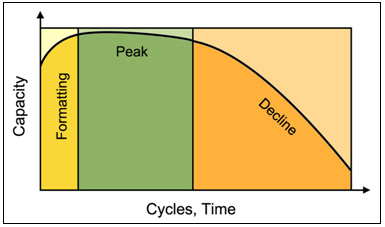Hi acei,
Are you custom ordering an RV? What are you planning on purchasing?
The two volt cells have a life span of up to twenty years.
Cell failure, statistically speaking is more likely with a greater number of cells.
Six volt batteries have 3 cells each. 6 x 3 = 18 cells to possibly fail, or three times the risk of failure.
sunfrost refrigeratorAs to sizing a solar system, in some ways it is a u shaped curve. The lower the amount of storage the greater the importance of having enough watts to get recharged quickly.
The bare minimum may be about 60 watts per 100 amp-hours. That is enough to allow equalization to be done.
Above 85% state of charge only about 12.5 amps of charging are accepted by the battery--and that number drops as the battery gets closer and closer to fully charged. 12.5 amps translates to 150 watts of panels per 100 amp-hours of storage.
Assuming you go with six six volt jars or 696 amp-hours the range of size the range of wattage would be about 420 to 1050 watts of panels.
My charging day starts at 30 minutes after sunrise and continues to sunset. By one hour after first light I harvest enough to meet the parasitic loads in the RV. Solar system "rule of thumb" is five hours per day at the rated panel output if the panels can be tilted. I chose to not tilt.
I added a 2nd bank of 500 amp-hours and have barely enough solar to equalize it. Without bank switching I'd be too low to do so. When boondocking I run out of grey water tank room before I run out of power, but I don't run a residential fridge either. In summer time I do run my water heater on electric.
There is an argument to be made for a 24, 36 or even a 48 volt battery bank.
Once you have decided on the wattage of panels and the voltage of the battery bank, look for a fully featured charge controller. If cost is not an object MPPT will wring move watts from the solar array than PWM. Try to find a controller that allows diversion loads, so that once the battery bank is full (or above 85% of full) the solar panels can be used for electric water heating or other loads.
My favorite controller under 500 watts (for non tilt installation) is the MPPT Rogue 3048 (made in USA)
Rogue 3048Over 500 watts the Tristar 60amp PWM controller is a great unit.
Over 800 watts consider a 24 volt battery bank.
What ever controller is decided on should include a temperature sensor on the battery. That will optimize the charging voltage. For the climate I live in (-40 to +42 C; -40 to 107 F) it is essential.
I do not think there is much difference between the cheapest panels available (as low as 68 cents per watt, from time to time) and the most expensive ones. I know of only one person who had a failure--and that was on a "name brand" panel of high reputation and quality. Save on the panels and buy a "top of the line" charge controller.
